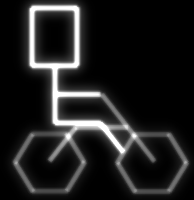I’m in the middle of refactoring all the drawing and positioning code for Stunt Man Rip it up and start again. This is quite a big job and does involve destroying not only huge swathes of code as I build automated routines to process data, but also throwing away data sets to produce more unified data models.
It’s often difficult to test code when you have to write so much before you can get some visual effects running. I’m using my title screen to test the code as I’m developing it before moving onto reworking all the game logic for jumping the buses.
During some of this initial testing I came across a bug, discussed here in this video
What’s interesting about this (well to me), is it shows how sometimes visual bugs can be a help. It has highlighted to me a semantic problem with my code, which may have been ignored for a long time. Not all bugs are bad. I still need to learn more about Dissi in VIDE so that I can do some more useful debugging than just straight breakpoints.
I’ve made some good progress so far and do have some interesting functional mechanics in place. Just got to finish refactoring the data for the bike and then I can work on the bigger job of reworking the game logic and then to start adding animation for the wheels and wheeling based on the inertia of the bike.
After that I will then have to tidy up and get of any outstanding and unnecessary data and work out what space I’ve got left to implement the other game modes I want to implement.







